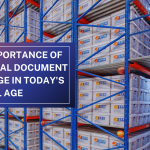In today’s digital age, it’s easy to forget that physical records still play a vital role in many businesses. Whether it’s legal documents, medical records, or financial statements, physical records need to be stored securely and accessed quickly when required. This is where physical records storage and management come into play, and it’s essential to have a proper system in place to ensure the safety and accessibility of your physical documents.

Physical Records Storage Solution
Offsite Records Storage: One of the most popular solutions for physical records storage is offsite storage. This involves storing your physical documents in a secure, climate-controlled facility managed by a third-party provider. Offsite storage frees up valuable office space and provides 24/7 security and accessibility to your documents.
Onsite Records Storage: Onsite storage involves keeping your physical documents in-house, either in a dedicated storage room or filing cabinet. While this option might seem convenient, it can be risky if you don’t have a proper records management system in place. Onsite storage can also take up valuable office space and make it difficult to access your documents quickly.
Cloud-Based Document Management: Cloud-based document management solutions provide a digital alternative to physical document storage. This solution involves scanning and digitizing your physical documents and storing them in a secure cloud-based system. This option provides quick and easy access to your documents from anywhere in the world and reduces the risk of loss or damage to physical documents.
Best Practices for Physical Records Management
Create a Document Retention Policy:
A document retention policy outlines how long you need to keep specific documents and when they can be destroyed. This policy ensures that you only keep necessary documents, reduces storage costs, and helps you stay compliant with legal and regulatory requirements.
Organize Your Documents:
Organizing your physical documents by category, date, or alphabetical order makes it easier to find specific documents quickly. Use color-coded labels or dividers to make it even easier to locate the document you need.
Implement Security Measures:
Physical document security is essential to protect sensitive information from theft or damage. Implement security measures such as access controls, surveillance cameras, and secure storage containers to ensure the safety of your physical documents.
Regularly Audit Your Documents:
Regularly auditing your physical documents ensures that you are keeping only necessary documents and disposing of outdated or unnecessary records. This practice reduces storage costs and minimizes the risk of data breaches.
Partner with a Professional Records Management Provider:
Partnering with a professional records management provider such as Securus ensures that your physical documents are stored securely and accessed quickly when required. Securus provides offsite records storage, document shredding, and cloud-based document management solutions to ensure that your physical documents are in safe hands.
In conclusion, physical document storage and management are essential for many businesses, and it’s crucial to have a proper system in place to ensure the safety and accessibility of your physical documents. By implementing best practices and partnering with a professional records management provider like Securus, you can ensure that your physical documents are secure and accessible when required.




